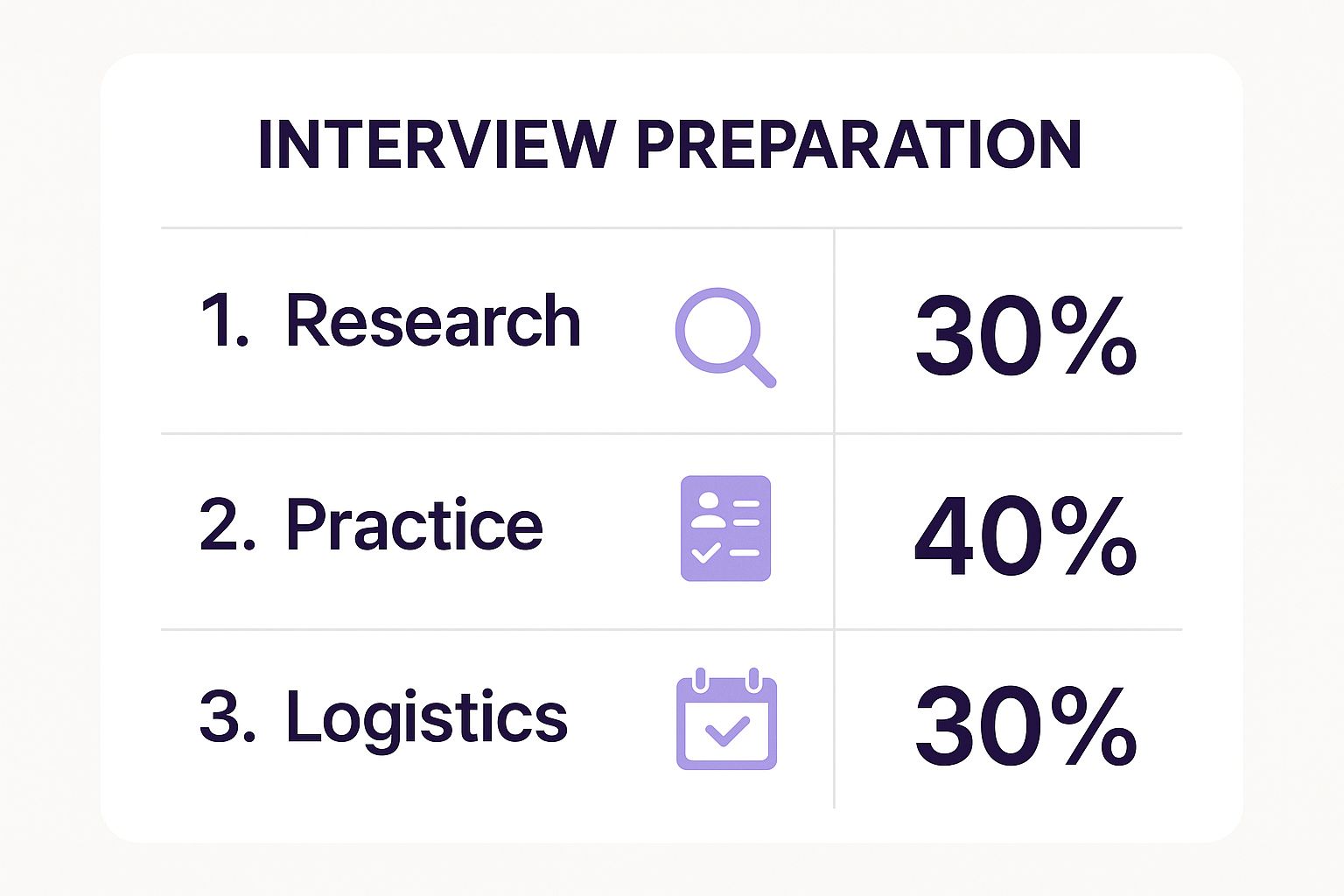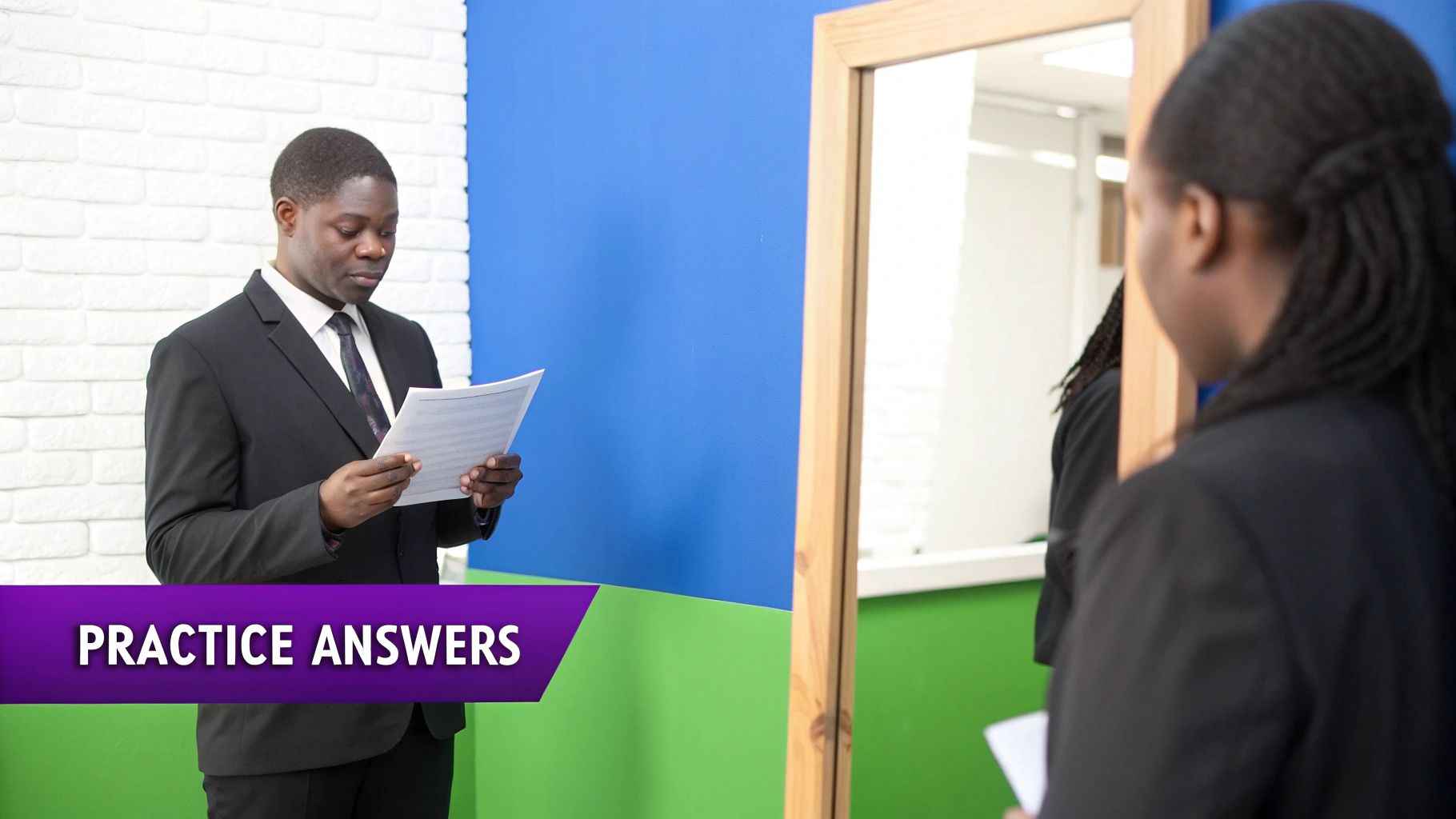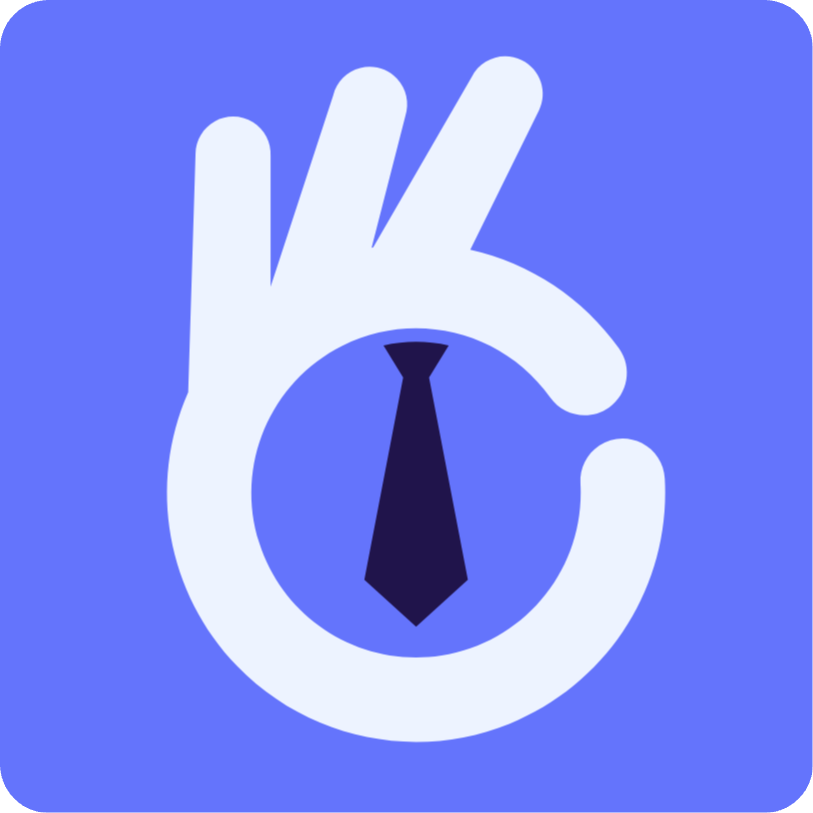How to Prepare for Job Interview: Expert Tips & Strategies
You know that feeling when you walk into an interview? It’s a mix of nerves and excitement. But what you might not realize is that the first five minutes can make or break your chances. It’s all about the first impression.
How you prepare doesn't just determine whether you walk in with confidence or anxiety; it sets the entire tone for the conversation that follows.
Mastering Your First Impression
Think about it: many candidates get so hung up on what they’re going to say that they completely forget about how they present themselves. A powerful first impression is more than just a firm handshake—it's a potent mix of solid preparation, genuine confidence, and sharp professionalism. It creates a psychological edge before you even get to the first question.
This isn't just a gut feeling; the data backs it up. Research shows that a staggering 69.5% of interviewers make their decision within the first five minutes. The same study found that non-verbal cues carry a huge weight, and 65% of managers admitted to rejecting candidates who couldn't maintain good eye contact. The small things really do matter.
Projecting Confidence and Professionalism
Confidence isn't something you can just flip on like a light switch. It's earned through diligent preparation and practice. One trick I’ve seen work wonders for calming those pre-interview jitters is using power poses right before you walk in. It might sound a bit silly, but it genuinely helps steady your nerves and project a more assured presence.
Your outfit plays a big part, too. It’s not about dropping a ton of money on a new suit; it’s about dressing for the company culture. Do a little recon on their social media or "About Us" page. Are they buttoned-up business formal, or do they have more of a relaxed startup vibe? When in doubt, it’s always a safer bet to be slightly overdressed than too casual.
Key Takeaway: Your arrival, handshake, and initial greeting are the first data points the interviewer collects on your professionalism. Aim to arrive 10-15 minutes early, offer a firm (but not bone-crushing) handshake, and make warm eye contact. It’s a simple formula for starting on a strong, positive note.
To help you nail those crucial first moments, here's a quick breakdown of what to focus on.
Quick Guide to Making a Strong First Impression
| Key Element | Why It Matters | Actionable Tip |
|---|---|---|
| Punctuality | Shows respect for the interviewer's time and your reliability. | Plan your route in advance and aim to arrive 10-15 minutes early. |
| Professional Attire | Demonstrates that you take the opportunity seriously. | Research the company culture and dress one level above their daily wear. |
| Confident Body Language | Non-verbal cues communicate confidence and engagement. | Sit up straight, maintain eye contact, and offer a firm handshake. |
| Initial Greeting | Sets a positive, friendly tone for the entire interview. | Smile, use the interviewer's name, and express enthusiasm for the opportunity. |
Mastering these elements ensures you start the conversation from a position of strength, making the interviewer more receptive to what you have to say.
Allocating Your Preparation Time
So, where should you focus your energy as you get ready? It's easy to get lost in the weeds of company research, but a balanced approach is key.

As you can see, practice deserves the lion's share of your attention. While research and logistics lay the groundwork, it’s the time you spend rehearsing your answers that builds the fluency and confidence you need to truly shine when it counts.
If you want to make those practice sessions as effective as possible, our guide on job interview practice has you covered with a structured approach.
Conducting Deep Company and Role Research

Let's be real: walking into an interview without knowing the company inside and out is one of the fastest ways to get shown the door. A quick glance at the homepage isn’t going to cut it. True preparation means you’ve dug deep to understand the company’s DNA—its mission, culture, recent challenges, and biggest wins.
This is what separates the casual applicant from the serious contender. It allows you to draw a straight line from your experience to their specific business needs. The hard truth is that a shocking 47% of candidates bomb their interviews simply because they didn't do their homework on the company and the role. When you’re up against over 100 other applicants for a single job, that deep research becomes your secret weapon.
Go Way Beyond the "About Us" Page
Your research needs to be a multi-front attack. You'll start with their website, of course, but don't you dare stop there. The goal is to build a complete profile of the organization.
- Their Website: Skip past the generic homepage copy. Head straight for the "Press," "Investor Relations," and "Blog" sections. This is where you'll find the good stuff—recent news, financial health reports, and clues about their strategic direction.
- Social Footprint: Check out their LinkedIn, Twitter, and even their Instagram. What are they posting? How do they talk about their employees? You'll get a real sense of their authentic company culture, not just the polished version.
- Competitor Intel: Who are their top two or three rivals? Understanding how the company stacks up in the market shows you're not just thinking about a job; you're thinking about the business.
Trying to keep all this straight in your head is a recipe for disaster. This is where a dedicated job search tracker comes in handy. You can create a section for each application to stash your notes, links, and key discoveries all in one place.
Deconstruct the Job Description
Think of the job description as your treasure map. It tells you exactly what problems the hiring manager needs solved. Don't just skim it for keywords—dissect it line by line to get to the heart of the role.
Pro Tip: I always print out the job description and grab two highlighters. I use one color for all the required skills and qualifications. With the other, I mark up the key responsibilities and outcomes they're looking for. This creates a visual map that makes it incredibly easy to connect the dots to my own experience.
Once you have this breakdown, you can start crafting your story. If they list "project management" as a key skill, you don't just say, "I have that." You prepare a specific example of a project you led, detailing the process, the challenges, and the successful outcome.
Align Your Skills with Their Core Values
Many companies are incredibly proud of their core values, and they often weave them into their behavioral interview questions. Hunt down these values—they're usually on the "About Us" or "Careers" page—and think about how your own work ethic lines up.
For instance, if one of their values is "Innovation," have a story ready about a time you suggested a new process or found a creative fix for a tough problem. This doesn't just show you have the skills; it shows you're the right cultural fit for their team. It’s this comprehensive approach that helps you deliver an interview performance that leaves a lasting, positive impression.
Weaving Your Career Story to Make an Impact

Your resume got you through the door—congratulations! But now, the real work begins. The interview is where you have to breathe life into those bullet points. Honestly, recruiters don't just want a laundry list of your old job duties; they want to hear the story behind your accomplishments and understand the real impact you made.
This is where storytelling becomes your secret weapon. Instead of just claiming you have a skill, you need to show it with a story they'll remember. The absolute best way I've found to frame these stories is the STAR method. It's a simple framework, but it's incredibly powerful for making your answers sharp, clear, and compelling.
How to Master the STAR Method
The STAR method is your ticket to turning a generic answer into a powerful narrative of achievement. It forces you to cover every point the interviewer is listening for, leaving no doubt about what you can do.
Here’s how it breaks down:
- Situation: Quickly set the stage. What was the project, the team environment, or the challenge you were up against?
- Task: What was your specific job in that scenario? What goal were you trying to hit?
- Action: Detail the steps you personally took. This is the core of the story where you showcase your skills in action.
- Result: What happened in the end? This is where you need to get specific. Use numbers and hard data whenever you can.
Think about the difference. "We improved efficiency" is vague and instantly forgettable. But an answer like, "I developed and rolled out a new workflow that cut our project turnaround time by 15% in just one quarter," tells a completely different story. It’s specific, it shows your direct contribution, and it provides cold, hard proof of your value.
Pro Tip: Don't try to memorize answers to dozens of potential questions. Instead, nail down five or six of your proudest career moments and practice telling their stories using the STAR method. You’ll find you can adapt these core stories to fit almost any behavioral question they throw at you.
Nailing the "Tell Me About Yourself" Question
Ah, the classic opener. This isn't just small talk; it's your first, best chance to make a strong impression. You've got about 90 seconds to deliver a killer elevator pitch that frames the entire conversation. My favorite way to structure this is the Present-Past-Future formula.
- Present: Kick things off with your current role and a recent, major win.
- Past: Briefly connect the dots to your past experience and how it prepared you.
- Future: Bring it home by explaining why you’re so excited about this company and this specific opportunity.
For example: "Right now, I'm a Project Manager at XYZ Corp, where my team just launched a new app 20% ahead of schedule (Present). Before this, I was at ABC Inc., where I really cut my teeth on agile project management, laying the groundwork for the larger projects I manage today (Past). I was so excited to see this opening because it’s a chance to apply my skills to a much larger, more global initiative, which is exactly where I want to take my career (Future)."
This structure shows you’re not just looking for any job. It proves you're strategic, focused, and have a clear idea of how you’ll fit into their team. It’s the perfect launchpad for telling your unique career story with confidence.
Asking Questions That Show You're a Contender
Sooner or later, every interviewer asks it: "Do you have any questions for us?"
I've seen it happen time and time again—a promising candidate gets to the end of a great interview, and when that question comes, they just say, "Nope, I think you've covered everything." It’s a huge missed opportunity. Saying you have no questions can come across as a lack of genuine interest or curiosity.
This isn’t just a formality to wrap things up. It’s your chance to turn the tables and show how deeply you've been thinking about the role, the team, and the company. The questions you ask are just as revealing as the answers you gave.
Moving From Generic to Strategic Questions
Your goal here is to shift the dynamic from a one-sided interrogation to a two-way, professional conversation. You're interviewing them just as much as they're interviewing you.
This is where all that research you did earlier really pays off. Forget the generic stuff about vacation days or the dress code. Your questions should prove you've done your homework and are already picturing yourself solving their problems.
A really powerful question connects what you can do with what they need to achieve. So instead of asking something generic like, "What's a typical day like?", you can dig deeper.
Key Takeaway: Start thinking like a consultant. If you were hired to come in and make an immediate impact, what would you need to know? Frame your questions to gather that critical info. This changes your entire posture from passive applicant to active problem-solver.
For example, you could ask, "I'm curious about how the team measures success. What are the most important KPIs for this position, and how would I contribute to hitting those in the first 90 days?" See the difference? That's a question from someone who is focused on results.
If you want to see more examples, this breakdown of 5 great questions to ask recruiters during an interview explains the thinking behind what makes them so effective.
Crafting Questions That Make an Impact
Never walk into an interview without at least 3 to 5 thoughtful questions ready to go. And these aren't just pulled out of thin air—they should be directly inspired by what you learned about their recent projects, their stated values, or challenges you picked up on in the job description.
Try to frame your questions around a few key areas:
- The Team: "Could you tell me a bit about the team's dynamic? Is it more of a collaborative environment where you brainstorm together, or do people tend to own their projects independently?"
- Success & Growth: "What does a successful onboarding process look like for this role? Are there specific milestones you'd expect someone to hit in their first 6 months?"
- Company Strategy: "I saw the recent press release about the expansion into the European market. How do you envision this role playing a part in that initiative?"
Feeling stuck trying to come up with questions that are both smart and relevant? Sometimes you just need a little inspiration. An interview question generator can be a fantastic way to spark some ideas. It can help you formulate those insightful inquiries that show you're not just looking for any job—you're looking for this job.
Executing a Follow-Up That Secures the Offer

The interview doesn't really end when you walk out the door. I've seen it time and again—the minutes and hours that follow are your last, best chance to seal the deal. A sharp, thoughtful follow-up message can be the very thing that pushes a hiring manager’s decision in your favor.
It's a simple step, but you'd be surprised how many people skip it. A staggering 57% of job seekers never send a thank-you note. That’s a huge missed opportunity, especially when 80% of hiring managers admit it influences their final decision. For 22% of them, it’s a make-or-break factor.
Sending a follow-up is an easy win that puts you ahead of the pack.
Timing and Personalization Are Everything
When it comes to the follow-up, speed is your friend. You should aim to get that email out within 24 hours of the interview. This keeps you top-of-mind while the conversation is still fresh for everyone involved.
But here’s the most important part: your message has to be personal. If you met with three different people, you need to send three different notes. Trust me, we can spot a generic copy-paste job from a mile away, and it does more harm than good. Each email needs its own flavor, referencing something specific you discussed with that person.
Key Takeaway: The whole point is to rekindle the connection you built. A personalized note proves you were listening and are genuinely interested. It turns a simple courtesy into a memorable final impression.
Crafting the Perfect Follow-Up Message
Your thank-you note doesn't need to be a novel. It should be concise, professional, and pack a punch. To make sure it lands just right, it helps to brush up on your effective written communication skills.
I've found a simple structure that works every time:
- A Clear Subject Line: Keep it simple and direct. Something like, "Thank you – [Your Name]" or "Following up on the [Job Title] interview" is perfect.
- A Personal Anchor: Kick things off by thanking them for their time. Then, drop in a specific detail you enjoyed discussing. For example, "I particularly enjoyed our conversation about the team’s new approach to client onboarding."
- Reiterate Your Value: Briefly connect a key job requirement to your own skills. For instance, "Hearing about the need for strong data analysis, I'm confident my experience building dashboards would allow me to contribute quickly."
- Express Genuine Enthusiasm: End on a high note by reaffirming your interest. A simple, "I'm very excited about this opportunity and look forward to hearing about the next steps," works wonders.
This final touchpoint is a non-negotiable part of the process. Mastering it is just one of the strategies that can seriously speed up your job search. For more advice, check out our guide on how to get hired faster.
Answering Those Tricky Interview Questions
No matter how much you prepare, some questions just feel designed to trip you up. Getting comfortable with these common curveballs is the final layer of polish that can make all the difference. Let's walk through a few of the questions that pop up time and time again.
"So, Tell Me About Yourself."
Ah, the classic opener. This isn't your cue to recite your life story. Think of it as your professional highlight reel. A simple and effective way to frame your answer is the "Present-Past-Future" model.
- Present: Kick things off with what you're doing right now. Mention your current role and a significant accomplishment that's relevant to the job you're interviewing for.
- Past: Briefly connect the dots. Explain how your previous experiences gave you the skills you're using today.
- Future: Bring it home by explaining why this specific role with this company is the logical next step for you and how you see yourself contributing.
The key is to keep it punchy. Aim for about 90 seconds. You want to deliver a compelling snapshot of who you are professionally, setting a confident tone right from the start.
"How Should I Prepare for a Virtual Interview?"
A video interview demands just as much preparation as a face-to-face meeting, with the added fun of technology. First things first: test your tech. Do a dry run to check your camera, mic, and internet connection. The last thing you want is a technical glitch throwing you off your game.
Find a quiet spot with good lighting and a simple, professional background. And yes, you still need to dress the part. When the call starts, make a real effort to look at the camera, not just the screen—it’s the virtual equivalent of making eye contact. Finally, shut down all distractions. Close those extra browser tabs, silence your phone, and let your housemates know you’re off-limits.
A huge mistake I see people make is getting too casual on a video call. Your setup and how you present yourself are part of your first impression. A stable connection and a distraction-free space tell the interviewer you're taking this seriously.
"What Are Your Salary Expectations?"
This question can feel like walking a tightrope, but it doesn't have to be a trap. The best approach is to either politely deflect or provide a range backed by solid research.
If you’d rather wait, you can say something like, "Right now, my priority is learning more about the role to see if we have a great match. I’m confident that if we both feel it's the right fit, we can agree on a salary that's fair for both of us."
If you have to give a number, don't pull one out of thin air. Offer a salary range based on what you’ve found for similar roles in your industry and location. This shows you’ve done your homework and know your market value. A range also gives you room to negotiate later, instead of locking you into one figure too early.
"How Many Questions Should I Ask the Interviewer?"
You absolutely need to have questions ready. It shows you’re engaged and genuinely curious. I recommend preparing 3 to 5 thoughtful questions. You might not get to all of them, especially if some are answered during the conversation, but it's better to have too many than too few.
Your questions should go beyond the basics. Think about asking about:
- The team's culture and how they collaborate.
- What success looks like in the first 90 days.
- The biggest challenges or priorities for the team this year.
And if they don't mention it first, always ask about the next steps in the process. It's a clear signal that you're excited and ready to move forward.
Feeling like you're juggling too many details across different interviews? Eztrackr is designed to pull all of this together, from your company research notes to the specific questions you plan to ask. Take control of your job hunt with Eztrackr and focus on what really matters—landing the job.
 Interview Sidekick
Interview Sidekick